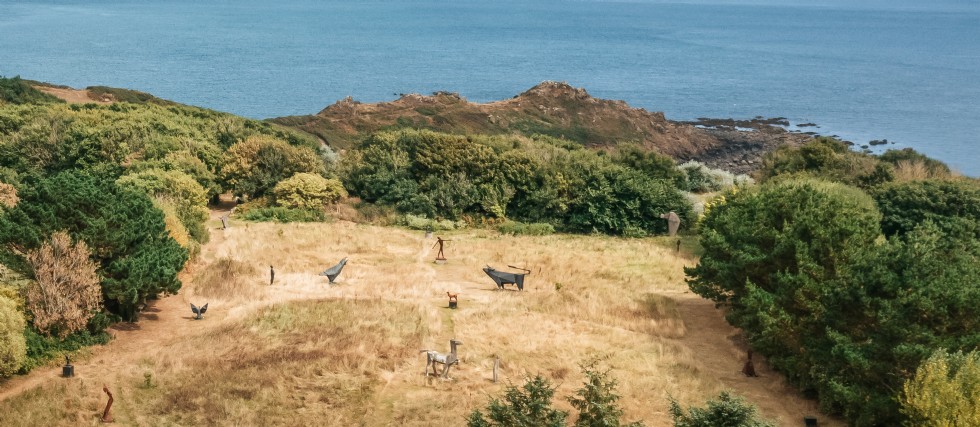A secret bungalow that nestles on an unspoiled slice of Cornwall’s coast. Unassuming in its nature, this was once the very place that one of Britain’s most prolific sculptors, Terence Coventry, called home, and now sits proudly within the grounds of his commemorative sculpture park. Reimagined by Terence’s son and daughter-in-law, James and Liz, Pomona is a place where the aesthetes go — an ode to art, to nature, and to memory.
Pomona’s story began in 1969 when it was built by James’ parents, Terence and Winifred, as a humble family home. And, despite over five decades of chapters in between then and now, many of the archetypically mid-century features of the property still remain; in the form of flowing open-plan rooms, large picture windows, and a retro, cashew-shaped swimming pool in the private garden.
But to understand its present, we first need to uncover its past. With Terence dedicating his time to farming when he moved to Cornwall from the West Midlands, it’s little wonder why nature played such an integral role in inspiring his artwork in his later life and, therefore, now appears as physical manifestations in and around the property: “the landscape, wildlife, and birds were his primary inspiration for sculpture,” James and Liz add. His minimalistic figurative sculptures cast in metal, for which Terence is most-renowned, embody creatures great and small; from bulls to birds, and emerge from the wild landscape throughout the open-to-the-public sculpture gardens in which the home quietly resides.
Whilst the sculptures are visibly connected to the fauna from Terence's life on the farm, his paintings are "slightly more flora-inspired,” they note. “Especially by the more sculptural plants that grow in the garden, or the barley that waves in the early summer Cornish breeze.” Although based in deepest Cornwall, Terence was commissioned worldwide and his work was regularly exhibited in London and beyond, including at the Pangolin Sculpture Gallery in King's Cross. To make up for lost time following his 25-year hiatus when farming the land, Terence decided to turn his hand back to his "first love" of art and, from that day forward, every day was spent creating up until his passing in 2017.
Despite his father’s fame, James’ childhood spent in Cornwall was one of happy simplicity: “As a boy, I don’t think I realised how lucky I was,” he adds. “I had my grandparents and the farm two minutes away, and I could reach Coverack village and my friends within a five-minute walk or short bike ride. There were numerous coves, beaches, and cliff areas to explore; which is all you can really wish for as a child growing up here.” And he's not wrong — Pomona's seaside setting is as idyllic as can be; just a short stroll away from the golden-sanded Porthbeer Cove.
Fast-forwarding to 2020, James and Liz set about renovating Pomona and, for James, one thing was key — that the house should of course pay homage to his father the artist, but also the father whom “decades of memories” were created with here. Pomona has a museum-like edge; where Terence’s original artwork adorns the walls throughout — from his early art school oil self-portraits and life drawings, to his colourful abstract paintings, to his simplified animal sketches that interlink with the exterior sculptures — posing as a physical retrospective of his diverse life’s work for guests to experience. “We feel the house mirrors the exterior elements that Terence loved so much,” they note. “Bringing them inside helps capture that snapshot of nature”; which is evident in the clever colour palette of peacock blue and moss green in the snug, organic materials such as paper lampshades, and the nature-embracing windows throughout.
The Terence Coventry Sculpture Park is free to visit, and is open year-round.
Feeling inspired? Aesthetes will enjoy reading about our architect-designed homes, discovering the culture club, or browsing the full collection of unique homes.









